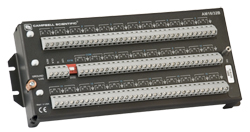The AM16/32B has replaced the AM16/32A. The AM16/32B supports two clocking modes:
Mode A works like the AM16/32A and sequentially advances through each channel.
Mode B uses a relay address to go directly to a specific channel—reducing power consumption and wear on the relay switches.
The new capability was added to allow it to work more efficiently with the AVW200-series vibrating wire interfaces.
The AM16/32B multiplexer allows our dataloggers to measure more sensors. The number of analog inputs is increased by sequentially multiplexing sensor leads into "common" leads. The individual common leads are connected to datalogger analog inputs, excitation channels, or ground as required by the sensor. The datalogger controls the multiplexer using two control ports or one control port and one excitation channel.
Compatible dataloggers include our CR10X, CR1000, CR800, CR850, CR3000, CR5000, and CR7. Please note that the AM16/32B is not compatible with our CR200-series, CR500, or CR510 dataloggers.

Features
Multiplexes up to 32 single-ended or differential two-wire sensors at a time
Alternately, multiplexes up to 16 single-ended or differential four-wire sensors at a time
Supports thermistors, potentiometers, load cells, strain gages, vibrating wire sensors, soil moisture sensors, etc.
Conforms to EN55022-1:1995 and EN50082-1:1992
CABLE3CBL-L, CABLE4CBL-L, and CABLE5CBL-L cables available to interface with datalogger
Specifications
Power: 9.6 to 16 Vdc (under load)
Current drain: <210 microamps quiescent; 6 mA active (typical)
Maximum actuation time for relay: 20 ms
Maximum switching current: 500 mA. Switching currents greater than 30 mA (occasional 50 mA acceptable) degrade the suitability of that channel for switching low-voltage signals.
Producing Area:USA